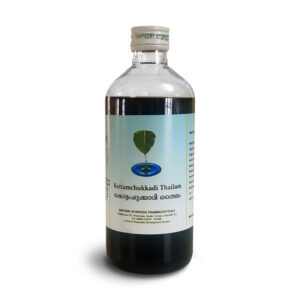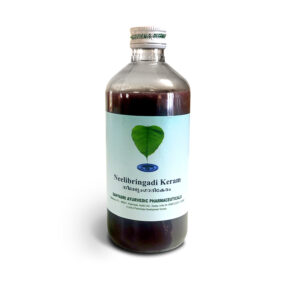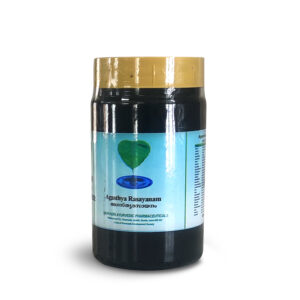Description
Vyoshadi Vatakam Ingredients
Sunthi (Zingiber officinale)
- Ginger is the universal medicine as per the ancient texts of Ayurveda
- It supports the digestive fire Agni and also aids in proper digestion. It is an immunity booster.
- Since it helps to eliminate and prevent Ama formation, it is very good for Ama related joint problems
- It is heated in nature and calms the Vata Dosha and balances Kapha Dosha
- Vyoshadi Vatakam uses ginger as an ingredient that helps in the Ayurvedic treatment of respiratory issues
- It is used in Ayurvedic medicine for sore throat infection
Maricha (Piper nigrum)
- Black Pepper
- Balances Kapha and Vata Doshas and aggravates Pitta Dosha
- It helps the digestive fire (Agni)
- Used in Ayurveda as an analgesic and antipyretic
Pippali (Piper longum)
- Root of Pepper
- Activates Agni or digestive fire
- Pacifies Vata and Kapha Doshas
- Improves the metabolism
- Used in Ayurveda as an analgesic and antipyretic
Amlavetasa (Rheum Emodi)
- Himalayan Rhubarb
- Useful in the Ayurvedic treatment of constipation, poor digestion, dysmenorrhea, urine retention, wound healing, jaundice, gingivitis, rhinitis and cough
- It reduces the vitiated Kapha and Pitta Doshas
- It is used in Ayurveda for its properties of being hepato-protective, anti-microbial, anti-fungal and anti-oxidant
- It is an Ayurvedic medicine for bronchitis cough
Chavya (Piper retrofractum)
- Useful in treating throat problems, colic, indigestion, intestinal worms, bloating, anorexia and Ayurvedic medicine for cold
- It is especially useful in traditional treatments of Vata disorders such as neuralgia and flatulence
- Supports and improves digestion
- Increases the Pitta Dosha and balances the Kapha and Vata Doshas
- It is similar to the properties of the long pepper root
Thalisapatra (Abies webbiana)
- This is a herb that has been used in traditional medicine to treat cough and colds.
- It has a distinctive aroma that is said to relieve stress and headaches just by its smell.
- The leaves are an important component of Ayurvedic medicine for sore throat, cough, sneezing, asthma, rhinitis, allergic rhinitis and infections of the upper respiratory tract.
- Its properties as per Ayurvedic medicine are anti-tussive, expectorant, a mucolytic, anti-inflammatory, bronchodilator, carminative, anti-bacterial, anti-microbial, anti-viral, carminative and astringent.
- It is a traditional respiratory tonic used in Ayurvedic medicine for bronchitis
- As it works to clear the excessive mucus production it is useful in the treatment of asthma and chronic bronchitis.
- It also has a beneficial effect on the sleeplessness that results from coughing all night and gives a night of sound sleep.
- It balances the Vata and Kapha Doshas
Chitraka (Plumbago zeylanicum)
- Pacifies Vata Dosha
- It is a good Ayurvedic medicine for treating throat pain and breathing disorders
- It balances the Vata and Kapha Doshas
- It is an Ayurvedic anti-inflammatory, carminative and digestive
- Improves digestive fire Agni
- It is one of the best Ayurvedic remedies for piles
Jeeraka (Cuminum cyminum)
- An excellent digestive stimulant.
- Promotes appetite
Tintidika (Tamarindus indica)
- Its leaves, fruit and oil have different uses in Ayurveda.
- Useful in the Ayurvedic treatment of non-healing wounds, cardiac issues, diabetes, urinary tract problems, bleeding disorders and wound cleansing
- Balances the Kapha and Vata Doshas
- Improves digestion
- To be avoided in people with high Pitta Dosha
Tvak (Cinnamomum zeylanicum)
- Is used in traditional medicine as a carminative, haemostatic, antiseptic, astringent, antispasmodic and Ayurvedic treatment for bronchitis.
Ela (Elettaria cardamomum)
- Cardamom
- It balances Kapha and Vata Doshas
- It is used in Ayurveda as an antioxidant in treating asthma, hypertension, dysuria and indigestion
Patra (Cinnamomum tamala)
- Useful in Ayurvedic treatment of inflammation of the uterus, tuberculosis, indigestion, flatulence, running nose and as a cardiac tonic and to improve renal function
- Reduces the vitiated Kapha and Vata Doshas
Guda (Jaggery)
- Balances the Vata and Pitta Doshas
- It is a blood purifier
Dosage
10 to 20 gms daily in divided doses or as directed by the physician.
Ayurvedic Perspective On Respiratory Disorders
Ayurveda defines breathing problems as Vata and Kapha related problems. Respiratory trouble is called Swasa Roga. Ayurveda describes three Doshas that govern the human body; the Vata, Pitta, and Kapha Doshas. Each person has their own individual Dosha balance that should be maintained to be in good health. When the Doshas are thrown out of balance, illnesses and disease result. The process of digestion is also vital to health. When the digestive process is good and efficient, the nutrition that is taken reaches the body tissues. The metabolism is efficient and there is no metabolic waste generated. Ayurveda calls metabolic waste Ama and this causes a host of health issues.
The Kapha Dosha is cold and slimy while the Vata Dosha is cold and dry in nature. The imbalance of these two Doshas starts in the digestive system and then moves to the lungs causing respiratory issues. The Kapha Dosha, the Kledaka Kapha when thrown out of balance causes the blocking of the lungs leading to bronchitis. The decongestion caused by Kapha Dosha is counteracted by increasing the Pitta Dosha in the body.
Bronchial asthma is called Tamaka Swasa. It is caused by improper food and other lifestyle habits. Some of the causes defined by Ayurvedic texts are:
- The intake of dry, cold or heavy food that is incompatible with the person’s body type
- Eating food that aggravates the Kapha Dosha
- Irregular eating habits
- Too much seafood, beans and black gram in the diet
- Too much exercise or sexual activity
- Suppression of natural bodily urges such as burping, eliminating the bowel contents, etc.
- Exposure to a cold climate or to allergens such as dust and smoke
- Any damage or physical trauma to any part of the respiratory system, throat, or chest.
Ayurveda looks at the treatment of asthma in a holistic manner. There are Doshas defined by Ayurveda that encompass the physical, mental, psyche, breath, and bliss bodies. When these Doshas are in good balance, the person is in good health. Unbalanced Doshas cause problems like asthma.
Ayurveda studies complete health from a perspective that encompasses the mind, body, and spirit. It defines that there are five Koshas. These are the Anamaya Kosha (the physical body), Pranaymaya Kosha (the breath body), Manomaya Kosha (the mind), Vijnanamaya Kosha (the psyche) and the Anandamay Kosha (the bliss body). These five Koshas should also be well balanced to attain good health. Asthma and Koshas are related. When a person has an attack of asthma, the physical body is affected by the tightening up of the lungs. The breath body is affected by the inability of the Prana or the breath to flow.
Annamaya Kosha – The person with asthma has difficulties with breathing, and the breath becomes very shallow. The lungs tighten up, and the air sacs do not expand. The emotions of fear, anger, stress, and depression affect the asthmatic person. So it can be concluded that the psyche, as well as the bliss body, are affected by the asthmatic person’s inability to connect to the life force.
Ayurveda does not treat asthma symptoms that need to be managed. Instead, it treats asthma by balancing the affected Doshas. The person has to make lifestyle changes to balance the Doshas and also have good digestion and metabolism. as well as correct the other factors involving emotions and the mind to resolve the Kosha blockages.
Asthma is the inability of the breath body or the life force Prana to move. So, when a person has asthma they are to be treated and supported not just by medication but also with psychological support. They are counselled to be able to handle all the negative emotions or depression that might be the trigger for asthma. A patient being treated for asthma has to be encouraged to maintain a positive outlook. Panchkarma treatment is prescribed for patients who are strong enough. Dietary recommendations are advised based on the affected Doshas. Food should be eaten warm and with an emphasis on a fresh and balanced diet. The person should have habits and eat food that does not aggravate the Dosha that is imbalanced.
Respiratory Disorders – An overview
Modern treatment for asthma uses medication to treat symptoms of an asthma attack. This is coupled with lifestyle changes to manage the disease. There are two types of asthma; T2 high or non-T2 ( or T2 low). T2 is due to allergic reactions and is called allergic or eosinophilic asthma because of elevated levels of eosinophils in blood or sputum. T2 asthma is more common in families that have a history of allergies. This can be skin or food allergies as well. When it occurs in childhood it usually improves as the child grows older. It can also occur later in life. It is easier to treat than the nonT2 type of asthma. It is also seen that due to the inflammation caused by this type of asthma there are elevated nitric oxide levels in the body.
People who have other asthmatics in the family are at a higher risk of suffering from the same. Being exposed to secondary smoke or having had a viral respiratory disease in childhood makes one more at risk for this type of asthma. Neutrophilic or non-T2 asthma is more difficult to treat. It is usually caused by obesity or other non-allergic factors.
The triggers for asthma differ from patient to patient. The common allergens that cause an asthma attack are mould, pollen dust, and animals. They can also be caused by infections or exercise, emotional stress, extreme temperature, or strong smells. Conventional wisdom advises that a patient avoid known triggers for asthma attacks.
Cold or cough may cause inflammation resulting in a sore throat and running nose. The mucus in the respiratory tract irritates the nerves in the lining and triggers a cough. The inflammation of the bronchial tubes causes bronchitis. Lung infections such as pneumonia are caused by viruses or bacteria. These problems are treated symptomatically. A non-viral infection would be treated with antibiotics. Colds and coughs are treated with anti-inflammatories, decongestants, cough suppressants, and expectorants. Asthma is not curable and is managed with corticosteroids (ICS), long-acting bronchodilators (LABA), anticholinergic agents, antimuscarinic agents, corticosteroids, and systemic steroids.






Reviews
There are no reviews yet.